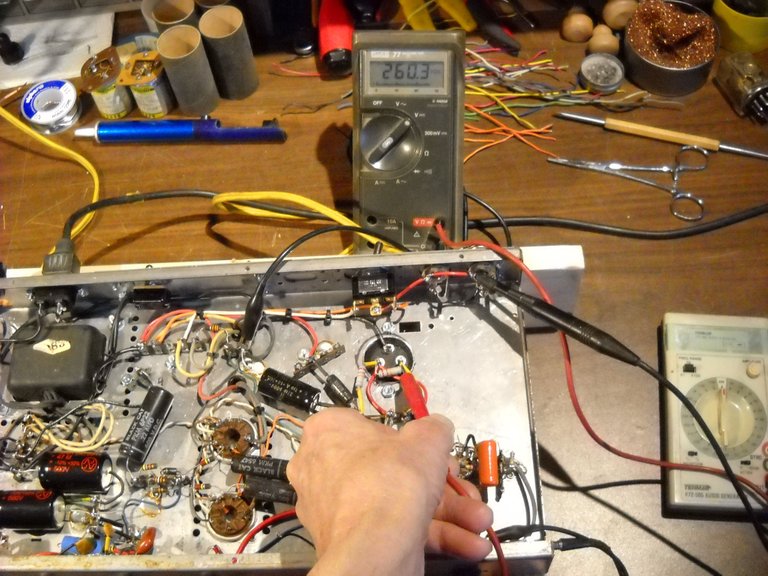Hello, steemians, and welcome to my page, eh!
I finally got back to this amp project, after being distracted by other things. When I started on it again, I found that when the amp was turned up during testing, the power supply would start fluctuating the voltage up and down, which is not a good sign at all. I wasn't sure what it was, but I decided to change the primary power supply filter capacitors to see if that would help. I figured that perhaps the ones I had in the amp couldn't handle the load. As it turned out, that was the problem. The ones I put in are designed for use in tube amps, the other ones were for use in TV power supplies and they weren't big enough. After I got that problem solved, I hooked up my ocilloscope and my signal generator and plugged in a dummy load to the speaker output for testing to find out how the amp handles the signal. Here's the setup.
This is what the signal looks like when you push it into distortion. There is both clipping at the top and bottom of the waves, and crossover distortion in the middle of the wave where one power tube takes over from the other in this push-pull configuration.
As you can see, my camera doesn't focus well with different light sources. The signal on the ocilloscop is the maximum undistorted signal at 1500 hz signal from the signal generator. The volt meter shows 437 volts DC at the primary power supply filter. The power supply drops voltage in relation to the load on it.
Looking at the other power supply points in the amp to check the voltages . This is the screen grid voltage. It's only slightly less than the plate voltage.
The next check point is the first preamp power supply point. Here we see a large drop in the voltage due to the resistor in between the screen grid point and the preamp point. The voltage here is 272 volts DC. The preamp tubes are only rated for 300 to 330 volts on the plate, so the voltage has to be dropped.
Here is the last test point, the second preamp power point. This one is at 260 volts. That's the last power supply point to test in this amp.
After all that testing was finished, I hooked up the speaker to the amp to test it with the bass guitar.
The amp still needs to have the preamp circuits built properly, it puts way too much signal into the power amp driver tube the way it is. That's just a matter of setting it up properly. I'm still thinking about building a switching system into the amp so I can switch between a clean setting and a distortion setting. I'm still working that part out. That will probably be part of the next post about this amp.
Well, that's all I have for this post, I hope you found it interesting!

Thanks for stopping by and checking out my post, eh!
If you would like to see the other posts on this amp, follow these links.
https://steemit.com/music-equipment/@amberyooper/repurposing-an-old-tube-amp-part-1
https://steemit.com/music-equipment/@amberyooper/repurposing-an-old-tube-amp-part-2
https://steemit.com/music-equipment/@amberyooper/repurposing-an-old-tube-amp-part-3
As always, feel free to leave a comment or a question if you would like.
May the Steem Force be with you!











I can't hear anything.
I turned up my speakers and still, nothing.
:-p
LOL!
I'm getting there...
It's good to see you tinkering again! I should really learn a thing or two Bout these amps, it may expand my understanding of frequency.
I suppose it could help with your understanding of frequency in some ways, but these amps just take a signal that you feed into it and make it louder. I think what you would be more interested in is what sound is, and how it is made up of different frequencies, and what that means. We can talk about that the next time I get a reading from you.
Oh yes please that's exactly what I mean 😀😊
You received an upvote from @MusicVoter and people following my Curation Trail due to the musical content of this post.
To find out how I decide who to up vote please READ THIS
Delegators get a higher upvote
Do you want to EARN CURATION REWARDS AUTOMATICALLY and help independent musicians?
HERE'S HOW